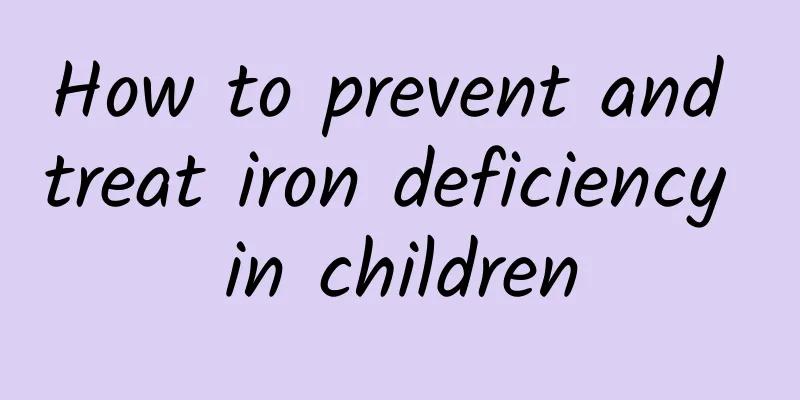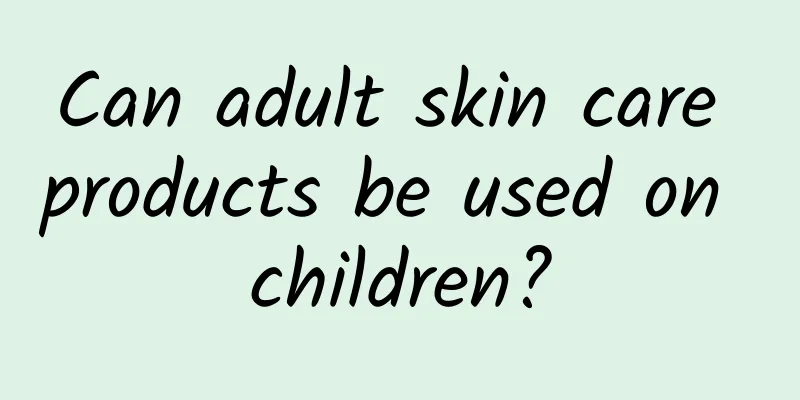How to prevent and treat iron deficiency in children

|
1. What is iron? Iron is one of the essential elements of the human body. An adult has about 4-5 grams of iron in his body, of which 72% exists in the form of hemoglobin, 3% in the form of myoglobin, 0.2 in the form of other compounds, and the rest is reserve iron. Reserve iron accounts for about 25%, which is mainly stored in the liver, spleen and bone marrow in the form of ferritin. 2. Functions of Iron[1] 1. Participate in the formation of hemoglobin and myoglobin. 2. Participate in the formation of iron-containing enzymes. Iron is a component of cytochrome and cytochrome oxidase, and plays a role in transferring electrons and generating energy during tissue respiration. Iron is also a component of enzymes such as catalase, peroxidase, phosphoenolpyruvate hydroxykinase, nucleotide reductase and xanthine oxidase, and participates in redox reactions in tissue cells. 3. It is related to the formation and maturation of red blood cells. When iron is deficient, the hemoglobin content in newly formed red blood cells decreases, and even hinders the synthesis of DNA and the division and proliferation of young red blood cells, which can reduce the deformability of red blood cells, shorten their lifespan, and increase their own hemolysis. 4. It is closely related to the human immune function. When iron is deficient, the number of lymphocytes, the activity of natural killer cells and the activity of biological antioxidant enzymes are reduced, the response of lymphocytes to antigens is slowed down, the speed of antibody production is slowed down and the number is reduced, resulting in a decline in immune function. 5. Participate in other important physiological functions. As a cofactor of enzymes involved in energy metabolism and body temperature regulation, it enhances the body's ability to regulate and adapt to changes in the environment and its own temperature (resistance to cold and heat). Iron catalyzes and promotes the conversion of β-carotene into vitamin A, the synthesis of purine and collagen, the transport of lipids in the blood, and the detoxification of drugs in the liver. 3. Clinical manifestations of iron deficiency 1. General symptoms: dizziness, blurred vision, shortness of breath, palpitations, pale skin and mucous membranes, fatigue, inattention, memory loss or forgetfulness, mild hepatosplenomegaly; loss of appetite, difficulty swallowing, nausea and belching, abdominal distension and diarrhea, and malabsorption; heart disease caused by iron deficiency is prone to left heart failure, and iron deficiency can trigger angina pectoris in patients with coronary artery sclerosis. 2. Skin and hair symptoms. For patients with long-term illness, the nails of the fingers and toes become wrinkled, rough, brittle and easy to break. In severe cases, the nails become flat or inverted; the skin becomes dry, sallow or pale; the hair becomes dry, easy to fall off or lose color (white hair). 3. Cardiovascular system symptoms. Tachycardia, strong heart beats, systolic murmurs can be heard at the apex or pulmonary valve area. Severe anemia can lead to anemic heart disease or congestive heart failure, and edema may also occur. 4. Digestive tract lesions. Decreased appetite or malabsorption. Severe iron deficiency anemia can cause mucosal tissue degenerative changes (atrophy) and tissue nutritional disorders, manifested as stomatitis, glossitis, and atrophy of tongue papillae. 75% of patients with iron deficiency anemia have gastritis (about 29% of normal people), which can be superficial gastritis or atrophic gastritis of varying degrees, accompanied by achlorhydria. 5. Decreased immune function and anti-infection ability. Both human and animal experiments have confirmed that iron deficiency leads to decreased immune function and anti-infection ability. This is especially common in infants and young children, manifested by decreased number of lymphocytes or poor transformation, weakened phagocytic function of macrophages and neutrophils, decreased peroxidase activity, and frequent and recurrent infectious diseases. 6. Reduced efficiency in work, activities and learning. When the body is iron deficient, the myoglobin content in skeletal muscle cells decreases, resulting in damage to biological oxidative metabolism, which manifests as decreased physical strength and endurance. Athletes’ training level and athletic ability decline, and their physical recovery after exercise slows down[2]. Children and adolescents experience stunted physical and intellectual development, lack of energy, poor concentration, reduced memory, weak learning ability and reduced efficiency. Adults become easily fatigued and recover more slowly, with weakened memory and forgetfulness. 7. Abnormal neuropsychiatric system. Especially in children, iron-deficient children are prone to irritability, irritability, lack of concentration, reduced cognitive ability, and lack of interest in people and things around them. About 1/3 of patients experience neuralgia and peripheral neuritis. In severe cases, increased intracranial pressure and papilledema may occur. Adults with iron deficiency are prone to indifference, rigidity, paranoia, stubbornness, dizziness, palpitations, decreased judgment, sleep disorders or decreased quality, and severe cases may lead to depression. Some iron-deficient patients have pica (such as eating soil, weeds, etc.), and the symptoms can disappear after iron supplementation. 8. Others. When iron is deficient, the body's ability to regulate body temperature in a cold environment is impaired, reducing the body's ability to resist the cold; adult women may experience menstrual disorders and amenorrhea; anemia in early pregnancy may lead to premature birth, low birth weight, premature infant and fetal death, etc. 4. How to prevent iron deficiency in children 1. Infants and young children should be given complementary foods in time. Egg yolks, fish paste, poultry blood, etc. should be added at 4-5 months; liver paste, minced meat, blood, red date paste, etc. should be added from 7 months onwards; in addition, premature infants from 2 months and full-term infants from 4 months onwards can be given iron supplements under the guidance of a doctor to strengthen prevention. 2. Avoid iron loss in daily life. Avoid drinking too much tea and coffee: because the tannic acid in tea and the polyphenols in coffee can form insoluble salts with iron, inhibiting iron absorption. 3. Cooking with an iron pan is easy for iron absorption. Use aluminum pans less often because aluminum affects iron absorption. 4. Take iron supplements in a timely manner, adhering to the principles of safety and efficiency. 5. Increase iron-rich foods. Make full use of economical and appropriate iron-rich foods in life. Rich sources: animal liver and blood, beef, mutton, chicken gizzards, clams and oysters, black fungus, black sesame, etc.; good sources: lean meat, pig kidney, sheep kidney, egg yolk, brown sugar, dried fruits (dried apricots, raisins), brewer's yeast, etc.; general sources: fish, lettuce, basella, spinach, lentils, peas, mustard leaves, broad beans, grains, etc.; trace sources: dairy products, vegetables and various fruits [3]; 6. Pay attention to food diversification and reasonable matching to increase the bioavailability of iron. Increasing the intake of foods rich in vitamin C can prevent and treat scurvy and promote iron absorption; adequate intake of foods rich in vitamin A, vitamin B2, B6, B12, and folic acid can help promote the production of red blood cells. 7. Iron-fortified foods. Use iron-fortified foods (mainly cereal foods) to prevent iron deficiency in high-risk groups. Trial iron-fortified soy sauce and iron-fortified flour have all played a certain preventive role. 8. Iron supplementation. High-risk groups such as infants, premature infants, twins, pregnant women, patients with partial gastrectomy, and repeated blood donors should prevent iron deficiency and can use oral iron supplements. 5. How to treat iron deficiency in children 1. Symptomatic treatment: For critically ill patients, on the basis of enhanced nursing care, targeted control and treatment of various infections or complications should be carried out. 2. Treat the cause. Try to find out the cause and treat it accordingly, such as treating hookworm disease, atrophic gastritis, ulcer bleeding, etc. 3. Oral or injection iron. Generally speaking, when the hemoglobin level of children is lower than 60g/L and accompanied by continuous bleeding, western medicine iron treatment can be considered. If necessary, injection iron can be used. Oral iron: ferrous sulfate, 500μg/L of free protoporphyrin in red blood cells (normal 200-400μg/L); ferrous fumarate 0.2g/time, 3 times/day, with a higher iron content and faster effect; ammonium ferric citrate is often prepared into a 10% solution for oral administration, 10ml/time, 3 times/day, which is trivalent iron and not easy to absorb, but can replace tablets; others include ferrous succinate, etc. Injection iron: It can be used for gastrointestinal diseases or those who urgently need to increase iron supply, such as dextran iron. 4. Others. When choosing plant foods rich in iron, increase the intake of meat and foods rich in vitamin C and copper; when choosing animal foods rich in iron, increase the intake of vitamin B2 and C; when providing iron-rich foods, choose foods rich in carotene or vitamin A; when choosing foods rich in iron, vitamin A and protein, increase the intake of vitamin B6 and potassium. All of the above can significantly improve the efficiency of iron supplementation. References [1] Deng Xiaoming. Iron deficiency and iron deficiency anemia and its dietary prevention and treatment[J]. Journal of Chongqing Vocational College of Industry and Trade, 2015. [2] Yu Hua, Li Jian. Public Basic Nutrition[M]. Sichuan University Press, 2006. [3] Ding Chenfang. Development of fortified foods abroad and its implications for my country[J]. Chinese Food and Nutrition, 2005. |
<<: Your baby has a fever. Have you chosen the right method to reduce fever?
Recommend
When does bayberry ripen? Why can't we eat too much bayberry?
Bayberry tastes sweet and sour, is rich in vitami...
Get pregnant as early as possible! HPV vaccines are free in many places...
The 2022 Government Work Report pointed out that ...
Gynecology What is the reason for scanty menstruation
There are many women who have normal menstruation...
Can jelly lipstick be eaten? How is jelly lipstick made?
Jelly lipstick is increasingly being liked and us...
Vulvar papilloma diagram
Private papilloma is a tumor derived from epithel...
What causes women to suffer from insomnia and dreaminess?
Insomnia is a neurological disease. Although it i...
What should I do if I feel bad and suffer from insomnia during the third month of pregnancy?
Many pregnant mothers have recently experienced m...
Vulva itching after menstruation
Some girls will find that their private parts and...
Dysmenorrhea Treatment with Traditional Chinese Medicine
Dysmenorrhea is a common problem for women, becau...
Is it normal for menstrual blood to smell sour?
When women find that there is a problem with mens...
Can I get vaccinated if I have HPV infection?
Cervical cancer is the second most common cancer ...
Abdominal pain on the fourth day after miscarriage
There are many reasons for miscarriage, some are ...
What is the cause of needle-like pain in the female urethra when urinating?
In daily life, many women are prone to stinging p...
What are the effects of abortion?
Women must be cautious when choosing abortion, es...
What are the symptoms of ureteral endometriosis?
Endometriosis means that the endometrium grows ou...









